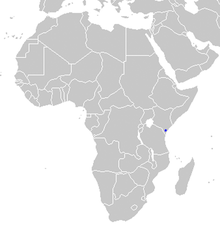Boulengerula taitana
Boulengerula taitana (commons names: Taita African caecilian, Taita Hills caecilian, Taita Mountains caecilian) is a species of caecilian. It is endemic to the Taita Hills region of southeast Kenya.[1][2]
| Boulengerula taitana | |
|---|---|
 | |
| Scientific classification | |
| Kingdom: | Animalia |
| Phylum: | Chordata |
| Class: | Amphibia |
| Order: | Gymnophiona |
| Clade: | Apoda |
| Family: | Herpelidae |
| Genus: | Boulengerula |
| Species: | B. taitana |
| Binomial name | |
| Boulengerula taitana Loveridge, 1935 | |
 | |
| Range highlighted in blue. | |
| Synonyms[2] | |
| |
Reproduction
Boulengerula taitana is an egg-laying burrowing caecilian. Because young specimens do not have the same tooth structure as adults, Boulengerula taitana has developed a strange habit. Once the young have hatched, the mother develops a thick, nutritious skin which the young eat. This does not appear to harm the adult. This behaviour is also found in its South American relative Siphonops annulatus.
The skin-feeding behavior of the young was captured on film for the BBC series Life in Cold Blood (released in 2008).[3]
Diet
Generally, Boulengerula are believed to be predators of soil macrofauna. The large proportion of decaying plant material and unidentifiable organic matter in guts of Boulengerula taitana has led to a suggestion that it is an omnivore or detritivore. However, the organic matter and soil in their diet seems to originate from prey items such as earthworms. Other important dietary items are termites, dipteran larvae and other soil macrofauna.[4]
Habitat and conservation
Boulengerula taitana occurs in montane forests and in secondary habitats, including plantation forests and cultivated land, at elevations of 1,000–1,900 m (3,300–6,200 ft) above sea level. It lives in soil, favouring moist soils rich in organic matter. It can be found in microhabitats such as under decomposing leaves, logs, and debris. It can also be found alongside permanent water, including drainage channels.[1]
Boulengerula taitana is locally abundant. It tolerates low-intensity agricultural practices, but is threatened by intensification of agriculture and deforestation. The overall population is believed to be declining. The forest fragments on the Taita Hills are protected by the Kenya Forest Service, but habitat disturbance still takes place. There are some plans for habitat rehabilitation.[1]
References
- IUCN SSC Amphibian Specialist Group (2013). "Boulengerula taitana". IUCN Red List of Threatened Species. 2013: e.T59498A16944134. doi:10.2305/IUCN.UK.2013-2.RLTS.T59498A16944134.en.
- Frost, Darrel R. (2018). "Boulengerula taitana Loveridge, 1935". Amphibian Species of the World: an Online Reference. Version 6.0. American Museum of Natural History. Retrieved 22 May 2018.
- "'Flesh-eating' amphibians filmed". BBC News. 9 February 2008. Retrieved 22 May 2018.
- Gaborieau, O. & Measey, G.J. (2004). "Termitivore or detritivore? A quantitative investigation into the diet of the East African caecilian Boulengerula taitanus (Amphibia: Gymnophiona: Caeciliidae)" (PDF). Animal Biology. 54: 45–56. doi:10.1163/157075604323010042. Archived from the original (PDF) on 2014-05-25.
